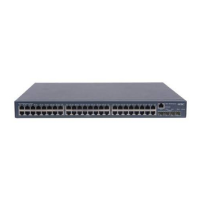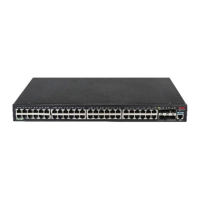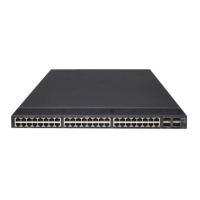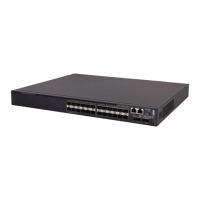1-2
z Selected: a selected port can forward user traffic.
z Unselected: an unselected port cannot forward user traffic.
The rate of an aggregate interface is the sum of the selected member ports’ rates. The duplex mode of
an aggregate interface is consistent with that of the selected member ports. Note that all selected
member ports use the same duplex mode.
For how the state of a member port is determined, refer to
Static aggregation mode and Dynamic
aggregation mode
.
LACP protocol
The Link Aggregation Control Protocol (LACP) is defined in IEEE 802.3ad. It uses link aggregation
control protocol data units (LACPDUs) for information exchange between LACP-enabled devices.
LACP is automatically enabled on interfaces in a dynamic aggregation group. For information about
dynamic aggregation groups, refer to
Dynamic aggregation mode. An LACP-enabled interface sends
LACPDUs to notify the remote system (the partner) of its system LACP priority, system MAC address,
LACP port priority, port number, and operational key. Upon receiving an LACPDU, the partner
compares the received information with the information received on other interfaces to determine the
interfaces that can operate as selected interfaces. This allows the two systems to reach an agreement
on which link aggregation member ports should be placed in selected state.
Marker protocol
During a session, if member ports are added to or removed from a dynamic link aggregation group,,
service traffic will need to be redistributed among all the new member ports of the link aggregation
group. The Marker protocol can be employed to quickly redistribute service traffic within link
aggregation groups and ensure the orderly transmission of data frames. The process is as follows:
z The device stops transmitting service traffic and starts a timer during which no data frames will be
transmitted on the links.
z The local end uses the Marker protocol to send a Marker Protocol Data Unit (PDU).
z When a Marker Response Protocol Data Unit (PDU) is received from the peer or the timer expires,
the device starts to redistribute service traffic on all the new link aggregation member ports in
selected state.
Currently, the S5120-EI series Ethernet switches support returning Marker Response PDUs only after
dynamic link aggregation member ports receive Marker PDUs.
Operational key
When aggregating ports, link aggregation control automatically assigns each port an operational key
based on the port attributes, including the configurations of the port rate, duplex mode and link state.
In a link aggregation group, all member ports in the selected state have the same operation key.

